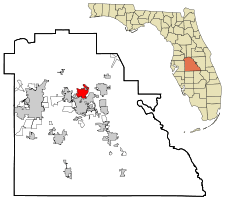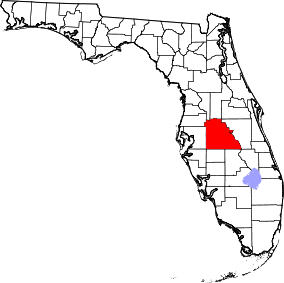Lake Alfred, Florida
| Lake Alfred, Florida | |
|---|---|
| City | |
 Location in Polk County and the state of Florida | |
| Coordinates: 28°5′37″N 81°43′30″W / 28.09361°N 81.72500°WCoordinates: 28°5′37″N 81°43′30″W / 28.09361°N 81.72500°W | |
| Country | United States |
| State | Florida |
| County | Polk |
| Incorporated | 1915[1] |
| Area | |
| • Total | 8.6 sq mi (22.2 km2) |
| • Land | 4.9 sq mi (12.7 km2) |
| • Water | 3.7 sq mi (9.5 km2) |
| Elevation | 174 ft (53 m) |
| Population (2013) | |
| • Total | 5,183 |
| • Density | 602.7/sq mi (408.1/km2) |
| Time zone | Eastern (EST) (UTC-5) |
| • Summer (DST) | EDT (UTC-4) |
| ZIP code | 33850 |
| Area code(s) | 863 |
| FIPS code | 12-37525[2] |
| GNIS feature ID | 0285214[3] |
Lake Alfred is a city in Polk County, Florida, United States. The population was approximately 5,183 in 2013.[4] It is part of the Lakeland–Winter Haven Metropolitan Statistical Area.
History
The city was established soon after the South Florida Railroad reached the area in 1883.[5] It had a number of early names, including Fargo, Chubb and Bartow Junction.
The settlement was named Fargo by snowbirds escaping the cold of Fargo, North Dakota. They at first named the settlement after their hometown, but the United States Postal Service protested after a series of mix-ups with the town of Largo.[6] The town then became Chubb and later Bartow Junction because it lay at the junction of a railroad leading south into the county seat Bartow.
The name Lake Alfred was adopted in 1913 and was taken from the nearest large lake, named for Alfred Parslow, who came to Florida in 1877 and obtained a charter to build the Jacksonville, Tampa and Key West Railroad.[7][8]
In 1917, the State of Florida established the first off-campus center for the University of Florida in Lake Alfred, the Citrus Experiment Station to study ways of improving citrus growing.[9] Today this location is known as the UF/IFAS Citrus Research and Education Center.
Geography and climate
Lake Alfred is located at 28°5′37″N 81°43′30″W / 28.09361°N 81.72500°W (28.093664, -81.724998).[10] Lake Alfred is located within the Central Florida Highlands area of the Atlantic coastal plain with a terrain consisting of flatland interspersed with gently rolling hills.[11]
According to the United States Census Bureau, the city has a total area of 8.6 square miles (22 km2), of which 4.9 square miles (13 km2) is land and 3.7 square miles (9.6 km2) (42.84%) is water.
Lake Alfred is located in the humid subtropical zone, as designated by the (Köppen climate classification: Cfa).[12]
Demographics
| Historical population | |||
|---|---|---|---|
| Census | Pop. | %± | |
| 1920 | 317 | — | |
| 1930 | 629 | 98.4% | |
| 1940 | 920 | 46.3% | |
| 1950 | 1,270 | 38.0% | |
| 1960 | 2,191 | 72.5% | |
| 1970 | 2,847 | 29.9% | |
| 1980 | 3,134 | 10.1% | |
| 1990 | 3,622 | 15.6% | |
| 2000 | 3,890 | 7.4% | |
| 2010 | 5,015 | 28.9% | |
| Est. 2015 | 5,475 | [13] | 9.2% |
As of the census[2] of 2000, there were 3,890 people, 1,511 households, and 1,103 families residing in the city. The population density was 793.6 inhabitants per square mile (306.5/km²). There were 1,741 housing units at an average density of 355.2 per square mile (137.2/km²). The racial makeup of the city was 78.25% White, 17.25% African American, 0.23% Native American, 0.80% Asian, 1.72% from other races, and 1.75% from two or more races. Hispanic or Latino of any race were 5.89% of the population.
There were 1,511 households out of which 32.0% had children under the age of 18 living with them, 55.0% were married couples living together, 14.7% had a female householder with no husband present, and 27.0% were non-families. 22.1% of all households were made up of individuals and 10.2% had someone living alone who was 65 years of age or older. The average household size was 2.54 and the average family size was 2.98.
In the city the population was spread out with 26.5% under the age of 18, 7.1% from 18 to 24, 27.2% from 25 to 44, 22.1% from 45 to 64, and 17.0% who were 65 years of age or older. The median age was 38 years. For every 100 females there were 87.1 males. For every 100 females age 18 and over, there were 83.9 males.
The median income for a household in the city was $36,809, and the median income for a family was $42,904. Males had a median income of $31,875 versus $20,445 for females. The per capita income for the city was $18,008. About 10.7% of families and 14.0% of the population were below the poverty line, including 24.1% of those under age 18 and 7.4% of those age 65 or over.
Transportation
- US 17/92 - Lake Alfred lies near the western end of the concurrency between US 17 and US 92. The concurrency of US 17/92 leads eastward to Haines City and further toward Kissimmee; US 17 leads southward to Winter Haven; and US 92, westward to Auburndale and further to Lakeland.
- CR 557 - Leads northward to I-4 and toward Polk City
The city is served by buses of Winter Haven Area Transit.
Government and infrastructure
The Florida Department of Citrus has its department of scientific research in Lake Alfred.[15]
Gallery
- Mansion at Mackay Gardens & Lakeside Preserve
- Lake Alfred Public Library
- Lake Rochelle boat ramp
References
- ↑ "Guide to Polk, Auburndale". The Ledger. Retrieved 2010-09-25.
- 1 2 "American FactFinder". United States Census Bureau. Retrieved 2008-01-31.
- ↑ "US Board on Geographic Names". United States Geological Survey. 2007-10-25. Retrieved 2008-01-31.
- ↑ U. S. Census Bureau Quick Facts, Internet website , accessed September 11, 2014.
- ↑ Frisbie, L.K. (1976) Yesterday's Polk County Imperial Publishing Company, Bartow, FL
- ↑ Whitehead, Bill (14 August 1960). "First Polk Settlers Had to Build Towns, Then Name Them". Lakeland Ledger. pp. 7–A. Retrieved 22 April 2015.
- ↑ Morris, A.(1995) Florida Place Names Pineapple Press
- ↑ "Names of Polk Cities" (PDF). Polk County Historical Association. March 1978. Retrieved 2010-09-25.
- ↑ "CES" (PDF). Polk County Historical Association. December 2003. p. 1. Retrieved 2010-09-25.
- ↑ "US Gazetteer files: 2010, 2000, and 1990". United States Census Bureau. 2011-02-12. Retrieved 2011-04-23.
- ↑ "Florida's Geological History". University of Florida. Retrieved 2010-10-14.
- ↑ "World Map of the Köppen-Geiger climate classification updated". University of Veterinary Medicine Vienna. 2008-11-06. Retrieved 2010-09-10.
- ↑ "Annual Estimates of the Resident Population for Incorporated Places: April 1, 2010 to July 1, 2015". Retrieved July 2, 2016.
- ↑ "Census of Population and Housing". Census.gov. Retrieved June 4, 2015.
- ↑ "Contact" (Archive). Florida Department of Citrus. Retrieved on September 13, 2015. "Florida Department of Citrus Scientific Research 700 Experiment Station Road Lake Alfred, Florida 33850 USA"
External links
| Wikivoyage has a travel guide for Lake Alfred. |
-
 Media related to Category:Lake Alfred, Florida at Wikimedia Commons
Media related to Category:Lake Alfred, Florida at Wikimedia Commons - City of Lake Alfred official site
